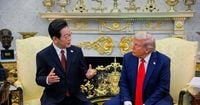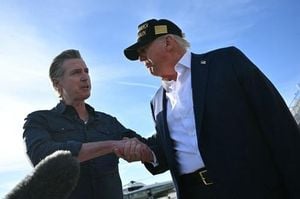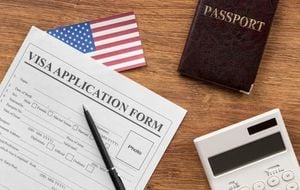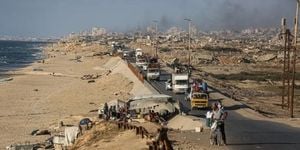On August 25, 2025, the White House was abuzz with diplomatic energy as South Korean President Lee Jae Myung made his first official visit to meet U.S. President Donald Trump. The summit, held in Washington, D.C., was a high-stakes affair, focused on strengthening the longstanding alliance between South Korea and the United States. Yet, as the dust settled and the official photos were released, it became clear that the cordial atmosphere captured on camera belied a complex web of unresolved issues lurking beneath the surface.
The White House, eager to showcase the positive tone of the meeting, unveiled about 40 photographs via its official Flickr account. These images, as reported by Yonhap and other outlets, depicted a series of warm exchanges: President Trump greeting President Lee at the West Wing entrance, the two leaders engaged in discussion at the Oval Office’s famed Resolute Desk, and even moments of levity as they viewed news coverage of their summit together. One particularly telling image showed Lee’s handwritten message in the guest book, expressing hope for a “strong and great future” for the South Korea-U.S. alliance—an alliance Lee has often described as the bedrock of his administration’s pragmatic diplomatic approach.
President Lee was not alone on his journey to Washington. He was accompanied by a cadre of top South Korean officials, including Chief of Staff Kang Hoon-sik, Foreign Minister Cho Hyun, National Security Advisor Wi Sung-lac, and Industry Minister Kim Jung-kwan. On the American side, Vice President J.D. Vance and Commerce Secretary Howard Lutnick were among those seen mingling with the visiting delegation. The images released by the White House also captured a lighter touch, such as the display of “Make America Great Again” hats—each one autographed and prepared as gifts for the South Korean officials, a gesture that underscored the friendly, if carefully managed, atmosphere.
But behind the scenes, the summit was anything but straightforward. According to Reuters, while the two presidents managed to avoid any public split and displayed what appeared to be genuine personal chemistry, the negotiations themselves were bogged down by a host of unresolved issues. Tariffs, defense costs, and a massive $350 billion investment fund all remained sticking points, with both sides unable to finalize even a joint statement or a fact sheet summarizing their progress.
National Security Advisor Wi Sung-lac acknowledged the slow pace of progress, noting that while significant strides had been made in some areas, others required further discussion and review. “If the negotiations for one minister doesn’t go well, they put a break on another negotiation that is going well,” Chief of Staff Kang Hoon-sik explained to reporters, highlighting just how interlinked the various issues had become. “We’ve overcome a significant obstacle, but there is still a long way to go.”
Among the most contentious matters was the fate of the $350 billion investment fund. Seoul, seeking to protect its interests, requested that equity account for only a fraction of the fund, rather than a mix of loans and equity as initially proposed. The United States, for its part, was pushing to open South Korea’s agriculture market—particularly rice and beef imports—while formalizing a 15% tariff cap on cars and semiconductor chips. As of late August, no final agreement had been reached on these points, leaving both sides in a state of limbo.
The auto industry, in particular, expressed anxiety over the impasse. An industry official, speaking to Reuters, did not mince words: “We are really worried... We are having big losses.” The uncertainty around tariffs and market access was, for many in the sector, a source of mounting frustration.
Complicating matters further were questions around defense cost sharing and the future of the 28,500 American troops stationed in South Korea. President Trump, in a post-summit address to his cabinet, acknowledged a “problem with South Korea” but noted that Seoul had “kept the same deal.” Details remained sparse, and neither Seoul nor Washington offered much clarity about what payments, if any, might be demanded for U.S. military presence. Adding a new wrinkle, Trump reportedly floated the idea of the U.S. owning the land on which its bases are located—a suggestion South Korean officials dismissed as politically unworkable and not formally requested by Washington.
Despite these hurdles, the summit was widely viewed as successful in maintaining the appearance of unity. Observers noted that, even as negotiations dragged on, both leaders managed to avoid any public falling out—a testament, perhaps, to the importance both sides place on the alliance in a turbulent global landscape.
Looking ahead, the diplomatic calendar remains packed. According to The Korea Herald, both President Lee and President Trump are scheduled to speak at the United Nations General Assembly High-Level Week in New York, beginning September 23, 2025. Lee’s address will focus on South Korea’s journey in overcoming democratic crises and outline his administration’s vision for major global issues, including the ever-volatile situation on the Korean Peninsula. The possibility of a second Lee-Trump meeting on the sidelines of the UN gathering has fueled speculation among diplomats and analysts alike, especially given the two leaders’ prior agreement on the need to revive talks with North Korea.
Should such a meeting materialize, it could serve as a bridge to the upcoming Asia-Pacific Economic Cooperation (APEC) summit, slated for October 31 to November 1 in Gyeongju, South Korea, where Trump is expected to attend. The presence of Japanese Prime Minister Shigeru Ishiba at the UN General Assembly adds another layer of intrigue, raising the prospect of a trilateral summit among South Korea, the U.S., and Japan—a symbolic reaffirmation of their commitment to regional cooperation under the second Trump administration.
President Lee’s diplomatic responsibilities in New York will not end with his General Assembly speech. For the first time during the annual gathering, a South Korean president will preside over a high-level open debate at the UN Security Council, focusing on “Artificial Intelligence and International Peace and Security.” As South Korea holds the rotating presidency of the Security Council for the second time during its current tenure as a nonpermanent member, Lee is expected to steer discussions on both the opportunities and risks posed by the rapid development of AI technologies. “Artificial intelligence — AI — for us is truly a future source of livelihood, or otherwise a future key industrial sector of ours, and an area for cultivating talent through both industry and academia,” presidential spokesperson Kang Yu-jung explained in a televised briefing.
The debate, scheduled for September 25, will examine the “dual nature of AI,” considering its potential for both peace and sustainable prosperity as well as the challenges it poses to international security. This marks a significant moment for South Korea’s global leadership, as the country continues its two-year term on the Security Council, which began in early 2024.
While the summit’s images painted a picture of warmth and cooperation, the reality behind closed doors remains far more complex. As both sides prepare for another round of high-profile diplomacy in New York, the world will be watching to see whether the cordiality on display in Washington can translate into concrete progress on the many issues still dividing these close allies.




